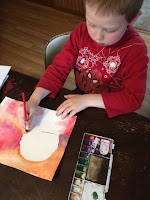Grandma, my dad's mom, was the only one of my grandparents to survive to see me reach adulthood. Her sweetheart, my Grandpa, died when I was in fourth grade. He was 63 at the time; she was 61. She stayed with us and saw my high school graduation. She let me stay with her that summer so that I could work and fund my college education; I worked like a dog at two full-time jobs, and in the off hours we toured places, had dinner and conversation together, sat by each other in Relief Society, and a hundred other little day-to-day treasures.
My parents had moved our family far from her, following my dad's job, and while we visited her nearly every year, it was more unusual for her to travel to us. She made one of her visits for my marriage to my own sweetheart in the Chicago Temple. A few years later, it was my privilege to stay with her again while we endured a period of unemployment my husband had after his field fell apart following 9-11. Once again, we went places, had long conversations, this time about life and the gospel, and so many other important things. She knew how much we wanted a baby, and was sad with us when it turned out I wasn't pregnant that one time. We sat together in Relief Society again. She introduced me to her friends.
Grandma played the organ at the Bountiful Temple, and sometimes I would tag along and do a session while she was working. A year or two before, she'd sent me some music that helped me to make the transition from pianist to organist when I was asked to play in my ward; Grandma was sweet like that. I hadn't even known that sort of material existed, and she just sent it to me, because she knew I needed it. Grandma was like that. I loved to hear her play the temple's organ. She cried when my husband found work and we left for the Midwest again. The couple of months that we had were precious, and I'm still counting the blessings that came to us from her kindness. My Grandma is an amazing woman.
Her last trip to the Midwest was Christmas of 2006. The whole family gathered. We had more people in the house Christmas morning than I think we've ever attempted since then: All eight of us kids were there, and a couple of us had spouses, all crammed into our little house. It was wall-to-wall people opening presents that morning. While she was here we took a four generation picture: Grandma, Daddy, me, and Hero.
She survived my Grandpa by twenty-two years: nearly a quarter century. I remember one conversation that I had with her after we'd left her home the second time, where I called a couple of days after their anniversary, and said that I'd thought to call and wish her a happy anniversary, but I hadn't been sure if that was a good idea. I'll never forget what she told me:
"I'm still married."
All my life, I'd heard about how Christ won the victory over death, about how He had taken the sting from death, but for me, there's never been a more profound sermon on what that means: she had such peace. Total confidence, the kind that makes a quiet, but immovable assertion:
"I'm still married." For time and all eternity.
I asked her to write down her and Grandpa's love story one time. I love the three plain, almost terse, paragraphs that she gave me, sketching how they met (she knew his sister), how they got to know each other through ordinary activities like a dance, play rehearsals, and snowshoeing up a nearby canyon. She told how he even stood her up once -- he'd been snowed in at his parents' house in Wyoming. The love she still had for him was apparent in every word.
The epistle to the Hebrews talks about Abraham's patient endurance; my Grandma exemplified that same thing every day of those twenty-two long years. She knew the truth of what Paul taught:
... hope we have as an anchor of the soul, both sure and steadfast...
-Hebrews 6:19
Christ was the reason for my grandmother's hope. She had accepted the invitation to yoke herself with the Prince of Peace, and she found the promised rest in Him.





























